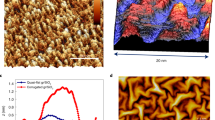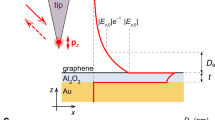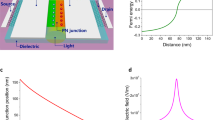Abstract
The ability to manipulate optical fields and the energy flow of light is central to modern information and communication technologies, as well as quantum information processing schemes. However, because photons do not possess charge, a way of controlling them efficiently by electrical means has so far proved elusive. A promising way to achieve electric control of light could be through plasmon polaritons—coupled excitations of photons and charge carriers—in graphene1,2,3,4,5. In this two-dimensional sheet of carbon atoms6, it is expected that plasmon polaritons and their associated optical fields can readily be tuned electrically by varying the graphene carrier density. Although evidence of optical graphene plasmon resonances has recently been obtained spectroscopically7,8, no experiments so far have directly resolved propagating plasmons in real space. Here we launch and detect propagating optical plasmons in tapered graphene nanostructures using near-field scattering microscopy with infrared excitation light9,10,11. We provide real-space images of plasmon fields, and find that the extracted plasmon wavelength is very short—more than 40 times smaller than the wavelength of illumination. We exploit this strong optical field confinement to turn a graphene nanostructure into a tunable resonant plasmonic cavity with extremely small mode volume. The cavity resonance is controlled in situ by gating the graphene, and in particular, complete switching on and off of the plasmon modes is demonstrated, thus paving the way towards graphene-based optical transistors. This successful alliance between nanoelectronics and nano-optics enables the development of active subwavelength-scale optics and a plethora of nano-optoelectronic devices and functionalities, such as tunable metamaterials12, nanoscale optical processing, and strongly enhanced light–matter interactions for quantum devices13 and biosensing applications.
This is a preview of subscription content, access via your institution
Access options
Subscribe to this journal
Receive 51 print issues and online access
$199.00 per year
only $3.90 per issue
Buy this article
- Purchase on Springer Link
- Instant access to full article PDF
Prices may be subject to local taxes which are calculated during checkout




Similar content being viewed by others
References
Wunsch, B., Stauber, T., Sols, F. & Guinea, F. Dynamical polarization of graphene at finite doping. N. J. Phys. 8, 318 (2006)
Hwang, E. H. &. das Sarma, S. Dielectric function, screening, and plasmons in two-dimensional graphene. Phys. Rev. B 75, 205418 (2007)
Polini, M. et al. Plasmons and the spectral function of graphene. Phys. Rev. B 77, 081411(R) (2008)
Jablan, M., Buljan, H. & Soljačić, M. Plasmonics in graphene at infrared frequencies. Phys. Rev. B 80, 245435 (2009)
Hill, A., Mikhailov, S. A. & Ziegler, K. Dielectric function and plasmons in graphene. Europhys. Lett. 87, 27005 (2009)
Novoselov, K. S. et al. Electric field effect in atomically thin carbon films. Science 306, 666–669 (2004)
Ju, L. et al. Graphene plasmonics for tunable terahertz metamaterials. Nature Nanotechnol. 6, 630–634 (2011)
Fei, Z. et al. Infrared nanoscopy of Dirac plasmons at the graphene–SiO2 interface. Nano Lett. 11, 4701–4705 (2011)
Keilmann, F. & Hillenbrand, R. Near-field microscopy by elastic light scattering from a tip. Phil. Trans. A 362, 787–805 (2004)
Huber, A., Ocelic, N., Kazantsev, D. & Hillenbrand, R. Near-field imaging of mid-infrared surface phonon polariton propagation. Appl. Phys. Lett. 87, 081103 (2005)
Novotny, L. & Hecht, B. Principles of Nano-optics (Cambridge Univ. Press, 2006)
Vakil, A. & Engheta, N. Transformation optics using graphene. Science 332, 1291–1294 (2011)
Koppens, F. H. L., Chang, D. E. & García de Abajo, F. J. Graphene plasmonics: a platform for strong light–matter interactions. Nano Lett. 11, 3370–3377 (2011)
Liu, Y., Willis, R., Emtsev, K. & Seyller, T. Plasmon dispersion and damping in electrically isolated two-dimensional charge sheets. Phys. Rev. B 78, 201403(R) (2008)
Eberlein, T. et al. Plasmon spectroscopy of free-standing graphene films. Phys. Rev. B 77, 233406 (2008)
Zhou, W. et al. Atomically localized plasmon enhancement in monolayer graphene. Nature Nanotechnol 7, 161–165 (2012)
Bostwick, A., Ohta, T., Seyller, T., Horn, K. & Rotenberg, E. Quasiparticle dynamics in graphene. Nature Phys. 3, 36–40 (2007)
Hillenbrand, R., Taubner, T. & Keilmann, F. Phonon-enhanced light matter interaction at the nanometre scale. Nature 418, 159–162 (2002)
Ocelic, N., Huber, A. & Hillenbrand, R. Pseudoheterodyne detection for background-free near-field spectroscopy. Appl. Phys. Lett. 89, 101124 (2006)
Camara, N. et al. Current status of self-organized epitaxial graphene ribbons on the C face of 6H–SiC substrates. J. Phys. D Appl. Phys. 43, 374011 (2010)
Castro Neto, A. H., Peres, N. M. R., Novoselov, K. S. & Geim, A. K. The electronic properties of graphene. Rev. Mod. Phys. 81, 109–162 (2009)
Crassee, I. et al. Multicomponent magneto-optical conductivity of multilayer graphene on SiC. Phys. Rev. B 84, 035103 (2011)
Hofmann, M., Zywietz, A., Karch, K. & Bechstedt, F. Lattice dynamics of SiC polytypes within the bond-charge model. Phys. Rev. B 50, 13401 (1994)
Fei, Z. et al. Gate-tuning of graphene plasmons revealed by infrared nano-imaging. Nature http://dx.doi.org/10.1038/nature11253 (this issue)
Christensen, J., Manjavacas, A., Thongrattanasiri, S., Koppens, F. H. L. & García de Abajo, F. J. Graphene plasmon waveguiding and hybridization in individual and paired nanoribbons. ACS Nano 6, 431–440 (2012)
Atwater, H. A. The promise of plasmonics. Sci. Am. 296, 56–62 (2007)
Zia, R., Schuller, J. A., Chandran, A. & Brongersma, M. L. Plasmonics: the next chip-scale technology. Mater. Today 9, 20–27 (2006)
Thongrattanasiri, S., Koppens, F. & García de Abajo, F. J. Complete optical absorption in periodically patterned graphene. Phys. Rev. Lett. 108, 047401 (2012)
Hecht, B., Bielefeldt, H., Novotny, L., Inouye, Y. & Pohl, D. W. Local excitation, scattering, and interference of surface plasmons. Phys. Rev. Lett 77, 1889–1892 (1996)
Nikitin, A. Y., Guinea, F., Garcia-Vidal, F. J. & Martín-Moreno, L. Edge and waveguide terahertz surface plasmon modes in graphene microribbons. Phys. Rev. B 84, 161407(R) (2011)
Acknowledgements
We thank L. Novotny, N. van Hulst, R. Quidant and P. Jarillo-Herrero for discussions. This work was supported in part by the Fundacicio Cellex Barcelona, the Spanish MICINN (MAT2010-14885 and Consolider NanoLight.es), the European FP7 projects FP7-HEALTH-F5-2009-241818-NANOANTENNA, FP7-ICT- 2009-4-248909-LIMA and FP7-ICT-2009-4-248855-N4E, the ERC Starting grant no. 258461 (TERATOMO), and the ERC Career integration grant GRANOP.
Author information
Authors and Affiliations
Contributions
J.C., P.A.-G., F.H., F.H.L.K. and R.H. carried out the near-field imaging experiments and participated in data analysis. M.S. participated in data analysis. S.T. and F.J.G.d.A. contributed to the interpretation of the data and developed analytical and computational theoretical tools. N.C., P.G., A.C., A.P. and A.Z.E. provided materials. M.B. and J.O. fabricated the devices. J.G.d.A., R.H. and F.H.L.K. wrote the manuscript.
Corresponding authors
Ethics declarations
Competing interests
R.H. is co-founder of Neaspec GmbH, a company producing scattering-type scanning near-field optical microscope systems, such as the one used in this study. All other authors declare no competing financial interests.
Supplementary information
Supplementary Information
This file contains Supplementary Text and Data, Supplementary Figures 1-14 and Supplementary References. (PDF 3442 kb)
Rights and permissions
About this article
Cite this article
Chen, J., Badioli, M., Alonso-González, P. et al. Optical nano-imaging of gate-tunable graphene plasmons. Nature 487, 77–81 (2012). https://doi.org/10.1038/nature11254
Received:
Accepted:
Published:
Issue Date:
DOI: https://doi.org/10.1038/nature11254
This article is cited by
-
Synthesized complex-frequency excitation for ultrasensitive molecular sensing
eLight (2024)
-
Planar hyperbolic polaritons in 2D van der Waals materials
Nature Communications (2024)
-
Synergistic-potential engineering enables high-efficiency graphene photodetectors for near- to mid-infrared light
Nature Communications (2024)
-
Hyperbolic polaritonic crystals with configurable low-symmetry Bloch modes
Nature Communications (2023)
-
Highly directional and carrier density-independent plasmons in quasi-one-dimensional electron gas systems
Communications Physics (2023)
Comments
By submitting a comment you agree to abide by our Terms and Community Guidelines. If you find something abusive or that does not comply with our terms or guidelines please flag it as inappropriate.



